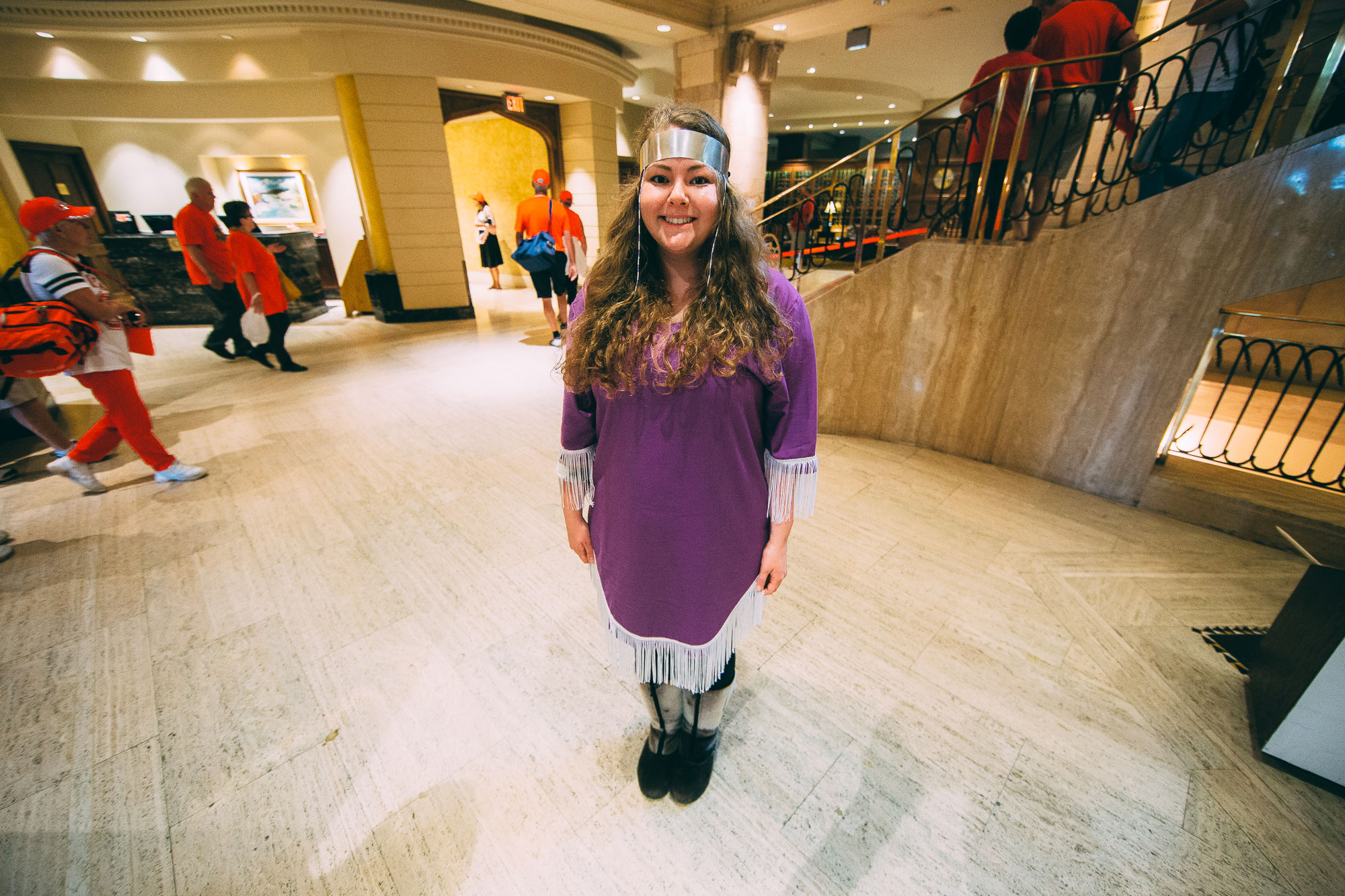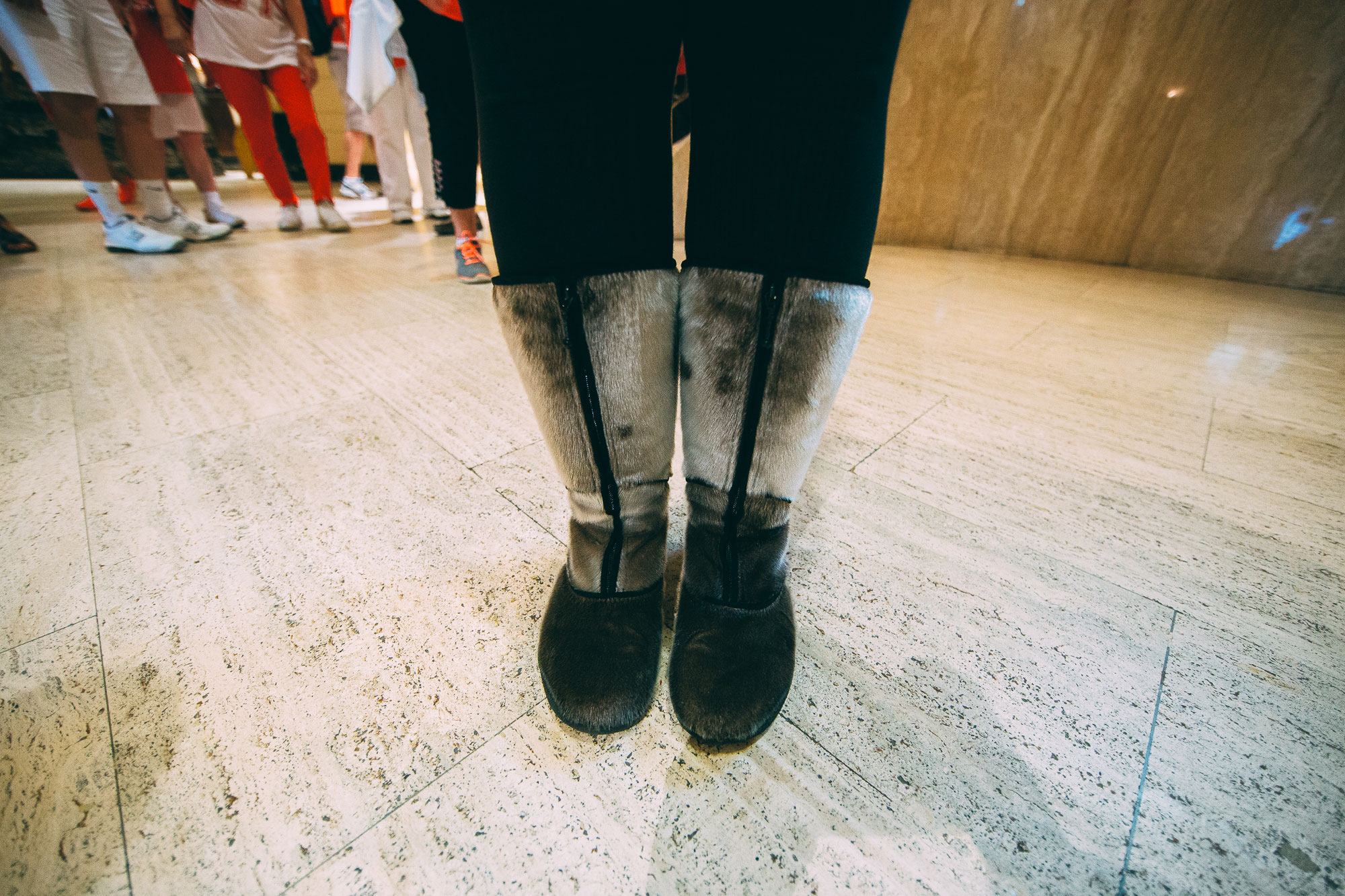I want to start by sharing this image of Lianna. It was rushed and not the easiest lighting but I think it captures her in a really accurate way: wearing her purple amauti among the red-and-white Canada 150 celebrators with a smile on her face, present and unapologetic about her culture and her voice. When I first met Lianna, she had just spoken to Prince Charles and the Duchess of Cambridge. She wasn’t in awe. She was indignant that she hadn’t gotten more time to speak to them about Inuit suicide.

“My name is Lianna Rice,” she said. “I’m an Inuk from Nunatsiavut, Labrador.”
It’s a little bit difficult to wrap my head around the scope of Labrador’s geography. We had thought that northwestern Newfoundland or the Gaspé Peninsula were remote. Where Lianna comes from, it’s a whole different story. “In Labrador,” she said, “we have a population of about 30,000 people for an area that’s about seven times the size of Switzerland. We’re spread across 31 communities. Some communities have as low as four people and the most populated has about 10,000 people.”
(I did the math and Labrador has 0.36% of Switzerland’s population.)
“I’m from Happy Valley-Goose Bay. We’re split into four different groups; there are three Indigenous groups of people, Inuit, Innu, Métis, as well as non-Indigenous.”
Not one to miss an opportunity to learn, I asked what the difference was between Inuit and Innu.
She raised her eyebrows. “What’s the difference between British and French? They’re different nations.”
I felt a little embarrassed but I was glad I had asked. It reminded me of the time that I asked an Irish person the difference between Ireland and Britain. Embarrassing, but still important to learn. I’m grateful for people who don’t hold questions like that against me.
Lianna described the spread-out community of Goose Bay, their schools, the hospital, the non-existent public transportation. I asked how it compared to other cities in Canada. She thought about it and laughed.
“I can't think of similarities between Goose Bay and a city.”
The last time Lianna had come to Ottawa it had been for Daughters of the Vote gathering marking a century of women’s suffrage. “Three hundred and thirty eight girls were chosen to come to Ottawa for this week-long conference about encouraging more young women into politics and advocacy. I represented the Labrador riding and I had the opportunity to speak in the House of Commons about the importance of including Inuit voices while addressing the issue of Inuit suicide.”
In a post on Facebook about meeting with the Duchess of Cambridge, Lianna wrote about her community having a suicide rate 40 times the national average. The underlying factors included access to education, housing crisis, identity issues, intergenerational trauma and a loss of culture.
“I imagine a Canada where Inuit won’t choose to attempt suicide like I did. A Canada where Inuit like my brother are still alive. Where my parents still have their son. Where my niece still has her dad.”
Lianna is engaged with Daughters of the Vote and her local MP Yvonne Jones, as well as a campaign to bring The Friendship Bench to her community to encourage conversations around mental health. But it wasn’t always that way. “With all of the social issues that my community is experiencing, a lot of youth, including myself up until this point, weren’t interested and motivated to get involved.” Now she’s working to change that. “I’m working for my MP and I’m going to start a Labrador Youth Council, for youth from all of the 31 communities in Labrador. Hopefully we’ll have a lot of interest.”
“Since there is only 30,000 people across 31 communities in a really large area, the youth don’t really get to connect with each other. Give youth the opportunity to actually talk together and talk about what they’re passionate about and what they want to see for the future of Labrador. Then they’ll actually be able to advise my MP on different things when they come together as a collective.”
During our interview, the streets outside were filled with people who had come to Ottawa to celebrate Canada 150. Lianna wasn’t celebrating. She described conflicting feelings, knowing both that many Indigenous peoples in Canada live in Third World conditions, and that Canada overall was a good place to live in comparison to other parts of the world.
But 150 years, from Lianna’s perspective, carried too much weight.
“Canada is celebrating 150 years of confederation, but confederation started without recognizing that Indigenous peoples, my people, were actually people. They’re celebrating women’s suffrage, but my people have only had the right to vote since 1969. So yeah, I’m definitely conflicted and I choose not to celebrate Canada 150. Throughout the past 150 years and before, there have been a lot of mistreatment of Indigenous peoples and it still happens today.”
“My mother’s mother, my anaatsiaq in my Inuktitut language, and my mom’s sister were both in residential schools. So the trauma that that has passed onto my family and the trauma of the oppression and cultural genocide of hundreds of years, that’s what’s being celebrated today.”
I asked her then, “If you’re not celebrating, what are you doing?”
“Today is a day for reflection for me,” she responded, “and a day to honour my ancestors, to be thankful that through all of this trauma, my people are resilient enough that I’m existing right now.”
The last thing we talked about was Muskrat Falls. I had heard about the hydroelectric damn being built last fall when protestors occupied the construction site as part of the Make Muskrat Right campaign. The fight in the fall and over the last several years was over the potential for methylmercury contamination of the Lake Melville ecosystem—and, through bioaccumulation, its inhabitants—since Nalcor wasn’t willing to fully clear the reservoir before flooding it. In late October, Newfoundland and Labrador Premier Dwight Ball and Indigenous leaders reached an agreement that established an independent expert advisory committee for the Muskrat Falls project.
Flooding, however, has become an issue this spring. This is the first spring that Nalcor has controlled the river’s flow, and members of Mud Lake, a community downstream from the dam, had to be airlifted after their land flooded for the first time in living memory.
“I live downstream from this,” said Lianna, “and there’s another community that lives downstream called Mud Lake. In Mud Lake, a lot of people have recently lost everything, lost their homes due to flooding and a lot of community members associate that with what’s been happening with the Muskrat Falls project.”
“There’s fear about the stability of the dam,” she added. “On that land there’s been landslides before, so people are concerned about the stability of that since the dam is being built on it.”
I looked it up and APTN reported the exact same thing, saying that the ultimate goal of the Labrador Land Protectors is now to shut the whole project down. I don’t know if that fight will be possible to win with the billions of dollars invested in its construction. Megaprojects are complex issues that inevitably have impacts on the community and environment. I don’t know enough about regional power generation, dam engineering or local politics to know where I stand on Muskrat Falls. I do, however, stand with Lianna on her final comment on the dam.
“Around the world development often takes place without the consent of Indigenous peoples.”

Before this conversation, I could not have placed Goose Bay on a map, let alone described some of the cultural, economic and social issues facing the people living there and in other parts of Labrador. Now, for me, that part of Canada has a face: an unafraid young woman with sealskin in her hands and a better vision for her people in her heart.